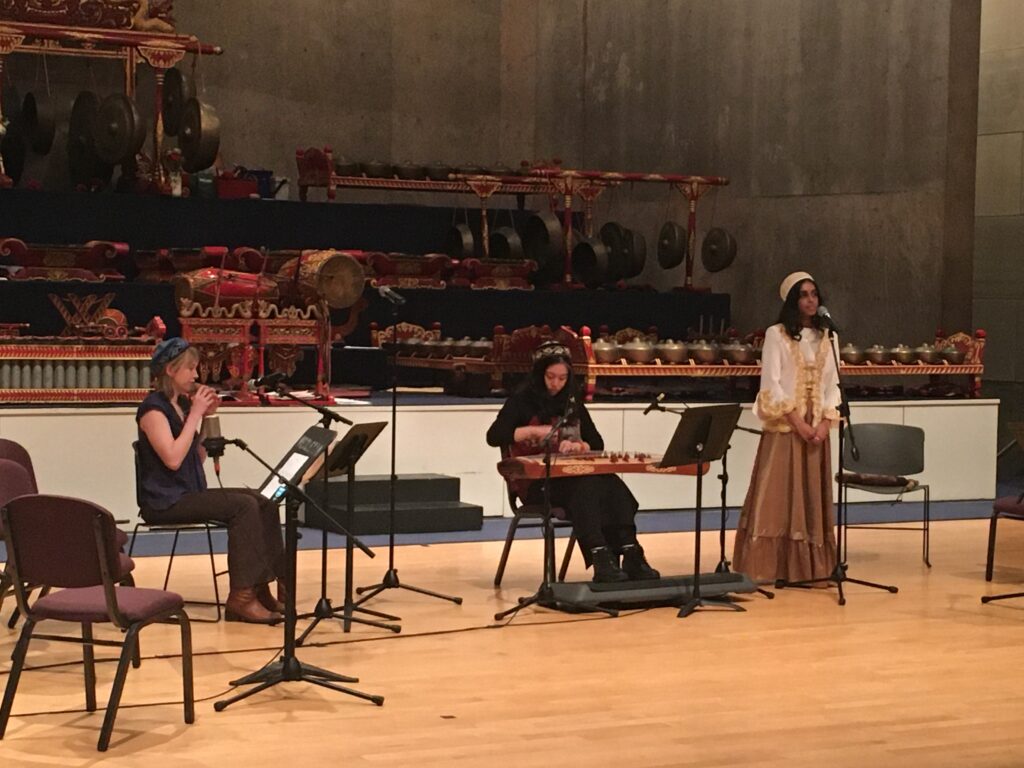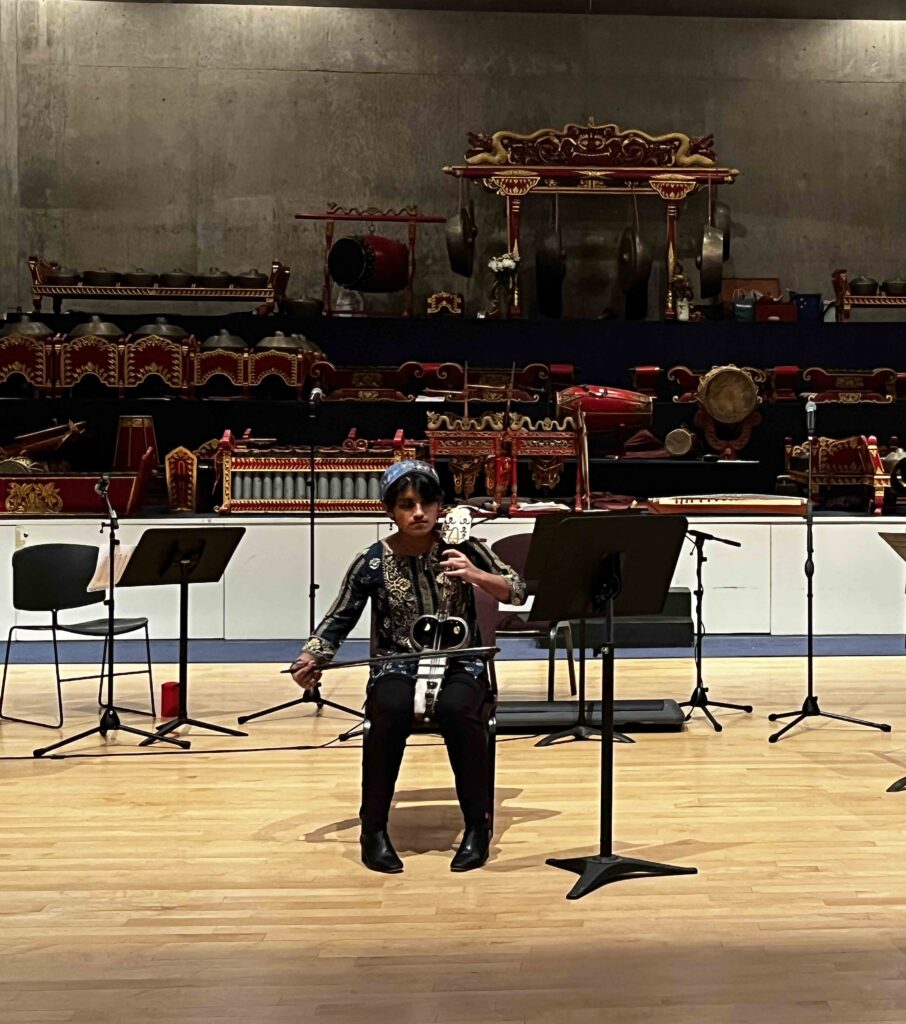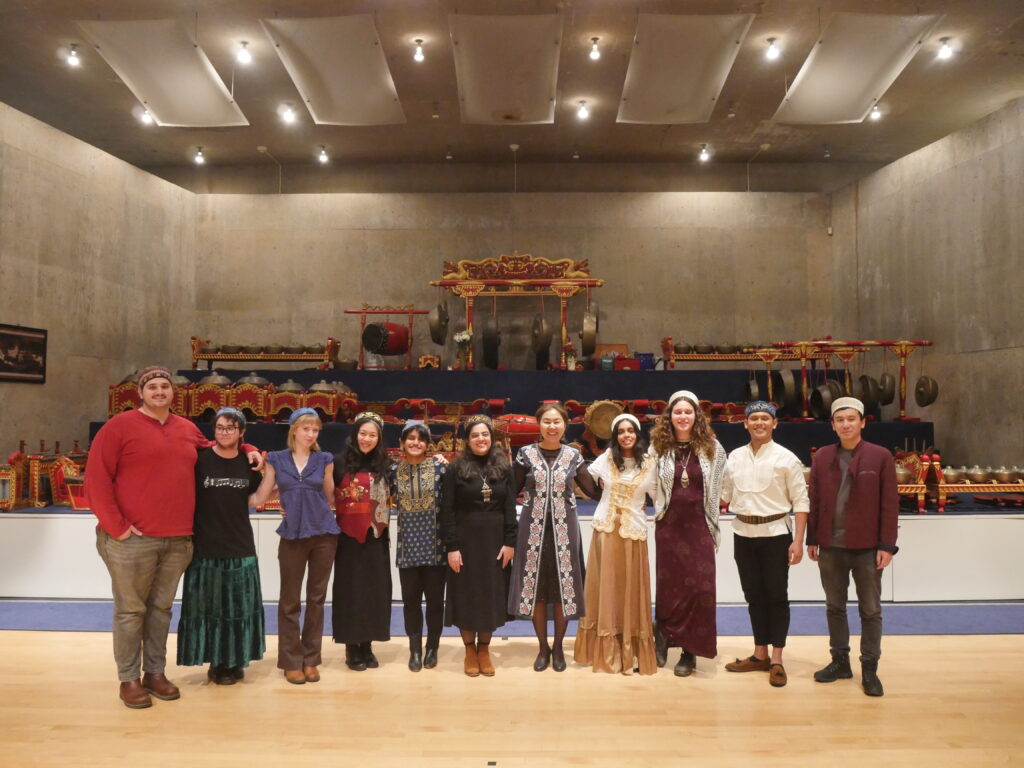by Oleksandra Volakova

Last December started with a unique concert by Wesleyan’s new Central Asian Music Ensemble featuring the Kazakh qyl-qobyz (bowed lute), dombyra (plucked lute), jetygen (plucked zither), saz-syrnai (clay ocarina), asatayaq (wand with bells), danghyra (frame drum), and the Kyrgyz temir ooz komuz (jaw harp). The ensemble was initiated by Professor Saida Daukeyeva and taught as a tutorial which offered practical instruction in music from post-Soviet Central Asia. The ensemble is one of very few such groups which exist outside the region itself. Its development was a collaborative endeavor supported by the Music Department, Academic Affairs, the Center for the Arts, and the Fries Center for Global Studies. Instruments for the ensemble were specially made by renowned artisans in Kazakhstan and Kyrgyzstan, and during the semester, three master musicians from Kazakhstan––Raushan Orazbaeva, Rüstem Nurkenov, and Zhaina Zharmukhametova––visited tutorial sessions virtually to give lessons to students on the qyl-qobyz, dombyra, and jetygen respectively.
Although the students had only been learning the new instruments for a single semester, their tutors were impressed by their progress. Instrument maker Tölegen Särsenbaev noted that their deep engagement with the repertoire and the particular nuances they brought to its performance “breathed new life into Kazakh music”.

Eva Yang, a PhD student in Ethnomusicology, learned how to play the jetygen (plucked zither). She appreciated that, unlike related instruments, such as the Chinese pipa, which she also plays, it does not need fake nails or fingerpicks: “It allows me to connect with the instrument closer by touching the strings and feeling their vibrations,” she said.
Hansini Bhasker, a first-year MA Music Performance student, added Central Asian songs to her existing repertoire of opera, jazz, and experimental vocals, by singing in Kazakh, accompanied by the ensemble. During her Bachelor’s Degree in Music at Princeton, she was introduced to Gaelic sean-nós (“old way”) songs, which she described as “deeply intertwined with their melodies”. Hansini observed affinities between the two styles of singing. “There was a haunting, sorrowful sound to many sean-nós songs, which I found replicated in various ways in the Kazakh pieces,” she remarked:
“There was a sense of nostalgia and yearning written into these Kazakh folk songs, whether they depicted loss that was a part of nomadic life, as nomadic units migrated away from each other throughout the year, and loved ones were separated (referenced in “Qara-ai közim”), or the loss of nomadic life itself, an idyllic, pastoral, organic form of living that shrank as Kazakh territories became colonized by Russia in the 19th century (an undercurrent of the music in “Aq Bayan”).”
Hansini found that learning Kazakh pronunciation was challenging, and she often used the International Phonetic Alphabet (IPA) to help her recreate the sounds: a process she enjoyed. For each of the three pieces she sang, she tried varying the style of singing: for “Aq Bayan,” she sang with vibrato as used in baroque opera; for “Qara-ai közim,” she used the belting style of R&B songs including light vibrato and melisma; while for “Qara jorgha,” a strong song normally sung by men, she used a more chanting style of singing.
Emerson Jenisch ’25, a Music major and Global Engagement minor, became acquainted with Central Asian music this semester; this short period allowed her to develop an interest in Central Asian instruments and music pieces, as well as their social, political, and historical contexts. Emerson already had 12 years of experience playing hammered dulcimer and five years playing piano. In the Central Asian Ensemble, she chose a very different instrument, the saz-syrnai (a clay wind instrument), being immediately intrigued by its natural sound. “My music is mostly inspired by elements of nature, and I was curious to explore saz-syrnai‘s historical associations with nomadism and human connection,” she commented. She found that learning the instrument was challenging because its tone and timbre shifts depend on the temperature and the environment. With practice, she learned how to best draw out its resonant sound.

Kriti Williams ’24 is a double-major in Neuroscience & Behavior and Music. Although she had no previous experience in Central Asian music prior to the seminar in Fall 2022, she grew up surrounded by music from a very young age. “I feel as though all kinds of music resonate with me, regardless of whether or not they are from cultures or traditions that I am familiar with,” she said. Kriti had been playing violin since she was 5 years old, and in the Central Asian Ensemble, applied herself to the bowed lute, the qyl-qobyz. She found her violin experience helpful in developing skills on the qobyz, although in some ways the experience was quite different. She explained: “The qobyz is held between my legs as I am seated, and the bow is dragged across the strings like cellists play, but with a different grip. There are only two strings, each made of horsehair, and to play a note, I would place my finger against the side of the string, instead of on top of it.” Kriti’s experience and application enabled her to master a piece considered to be advanced by the end of the semester.
The Central Asian Music Ensemble is still in its formative stages, but Professor Daukeyeva hopes to develop the tutorial into a full performance course in the future. The ensemble includes a variety of stringed, wind, and percussion instruments. For students wanting to play lutes, such as the qyl-qobyz or dombyra, previous experience on stringed instruments is desirable. Other instruments, such as the clay ocarina and the jaw harp, do not require prior experience, but do need practice, while percussion instruments, such as the frame drum, can be picked up fairly quickly even by non-music students. The ensemble is designed for students with a broad variety of academic backgrounds, majors, musical skills and experience and is open to anyone interested in learning about Central Asian music and culture. This is a fantastic opportunity to become familiar with them!



